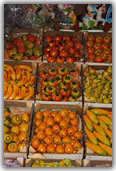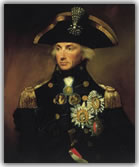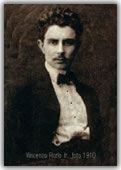| |
|
|
|
|
SicilyWine.
Stories and Legends from the Kitchen to the Cellar - 4 © |
|
|
|
|
|
THE BEAUTIFULLY SWEET ILLUSION OF THE "MARTORANA FRUIT" OR "MARZIPAN", AND PROCOPIO
 It was during the XVI century that one of the most famous almond desserts in the world was born, and it is credited to the nuns of the Church of Santa Maria dell’Ammiraglio, also known as “La Martorana”. It is said that the bishop requested the sisters prepare a table rich with beautiful and sweet fruits to welcome a visiting king to Palermo. However, being that it was January, the nuns had little chance of finding the types of fruit his eminence requested. Only a miracle, or something like it, would appease the whims of nobility! The resourceful ladies of the convent came up with a fantastical solution: they made a dough of sugar and almond flour, and worked it into mandarin, fig, apricot, and other shapes, adding color and details so realistic, they looked like beautiful pieces of actual fruit! And so frutta di martorana,
as it is known in Sicily, or “marzipan”, as it is known in the rest of the world, was born. It was during the XVI century that one of the most famous almond desserts in the world was born, and it is credited to the nuns of the Church of Santa Maria dell’Ammiraglio, also known as “La Martorana”. It is said that the bishop requested the sisters prepare a table rich with beautiful and sweet fruits to welcome a visiting king to Palermo. However, being that it was January, the nuns had little chance of finding the types of fruit his eminence requested. Only a miracle, or something like it, would appease the whims of nobility! The resourceful ladies of the convent came up with a fantastical solution: they made a dough of sugar and almond flour, and worked it into mandarin, fig, apricot, and other shapes, adding color and details so realistic, they looked like beautiful pieces of actual fruit! And so frutta di martorana,
as it is known in Sicily, or “marzipan”, as it is known in the rest of the world, was born.
During the period of Viceroys, the people of Sicily drank Spanish and French wines, like their rulers. However, there was always a place of honor reserved on each table for refreshing non-alcoholic beverages, such as almond milk with “snow” and ice creams, or gelati. And it was, indeed, a Sicilian chef by the name of Procopio dei Coltelli who first brought gelato to Paris toward the end of the 16th century, founding a gelateria called “Chez Procope”. Even today, in the place where the renowned gelateria had existed (it is said that it was frequented by French Revolutionary figures), there remains the eternal memory of the man who first introduced gelato to France. |
|
|
|
|
|
FROM THE SPANISH TO THE FLORIOS
The Spanish governed Sicily until 1713, and certainly not well. However, they do deserve the credit for reinvigorating the cultivation of vineyards and the production of wines all over the island.
The resulting wine was strong, full-bodied, and minimally refined, but it filled the barrels of the most important of the numerous taverns that were cropping up in the cities during that era, including the city of Palermo.
Artists, along with patrons of every type, frequented these rowdy and promiscuous locales, and very often, as happened in many other European cities, such as London, Paris, and Rome, drew inspiration for their works from them: imagine the places described by A. Dumas in “Les Miserables”, for instance.
Several poets, in Sicilian dialect and Italian language, praised and gushed over Sicilian wines, describing, among other things, their production processes from the grapevine to the cellar. To quote one of them, the great historian and Sicilian scholar, Domenico Scinà (Palermo, 1765-1837), wrote: “…Several species of our grapes can be called subtle, as did Cupani (another Sicilian poet), and the vine, trimmed well, was cultivated by us. But the wine is not drawn with the diligence it might be. Every sort of grape is mixed together, mature with immature, and is allowed to ferment arbitrarily, at the will of the ignorant farmer. Yet our wine is rich and robust, and makes famous the workers of Bagaria and Abbate” (Bagheria e Villabate).
Another famous Sicilian poet, Giovanni Meli (1740-1815), dedicated much of his writing to Sicilian wine and its virtues. Among these writings, we will cite:
Lodi ai vini Siciliani di Giovanni Meli (Ode to Sicilian Wines, by Giovanni Meli)
“ This will be a delight
Restoration of mortals
Remedy for sadness
Balsam for ills
It will bring balance,
In spite of destiny,
Among the rich and the poor
Among the greats and the commoners…”
“ Live live at full steam Moscato
of Catania or Syracuse… for wine you’ll drink Resalaimi…”
“…Live the garnish of the Ficarazzi
for we who drink bubbling wines”
“…Oh Castelvetrano, my love?
Oh Carini, Carini, oh what wine
That entraps my heart with sweetness…
Oh Alcamo, Oh Ciaculli! Oh Bagheria
Recipes for true contentment…”
In the second half of the 1700s, during the Bourbon Dynasty, wine cultivation was experiencing a full resurgence in Sicily.
Many wines were beginning to come into their own, reaching northern Italy as well as several foreign countries and the largest wine-producing cities, where, by that time, they boasted international quality, among which: Alcamo, Avola, Castellamare, Castelvetrano, Marsala, Mascali, Vittoria.
It was in that same period that several large proprietors of vineyards, such as Salaparuta, Ganci, and Mortillaro, began to produce more refined wines, according to the French model. One of the largest producers of Sicilian wine, Giuseppe Alliata Moncada Colonna, Prince of Villafranca and Duke of Salaparuta, was also convinced by this method. Don Giuseppe, who possessed a vast expanse of vineyards at Carini, Terrasini, Bagheria and Casteldaccia, oversaw his vineyards personally, and according to the particular manner of the Corvo di Bagheria district. Reserved for his family, as well as a few more illustrious guests, he bottled the first bottles of Corvo (beginning in 1800), creating the famous reserve known around the world. |
|
|
|
|
|
WOODHOUSE. NELSON. WHITAKER. THE ENGLISH TRADITION IN "SICILYWINE"
 Woodhouse landed at Marsala in 1773, and ‘discovered’ that the local wine produced in the area, and aged in wooden barrels, tasted similar to the Portuguese “Porto”. Eventually, this fortified wine found such success in England that he returned to Sicily in 1796, and became a pioneer in the mass production and commercialization of Marsala wine. Woodhouse landed at Marsala in 1773, and ‘discovered’ that the local wine produced in the area, and aged in wooden barrels, tasted similar to the Portuguese “Porto”. Eventually, this fortified wine found such success in England that he returned to Sicily in 1796, and became a pioneer in the mass production and commercialization of Marsala wine.
The legendary Admiral Horatio Nelson, who defeated Napoleon Bonaparte in the Battle of the Nile, spent a great deal of time in the northwest region of Sicily, between Palermo and Marsala. It was he who introduced Marsala wine to the British Navy as an alternative to Porto, and even suggested a regimen of one glass per day.
Joseph Whitaker, a young English entrepreneur and archeologist, inherited a vast vineyard in Marsala, upon which he founded a “baglio”, or typical Sicilian wine estate. From this baglio, Whitaker made a fortune exporting wine to the U.S. and England around the turn of the 19th century. In his later years, Whitaker is known to have bought the island of Mozia, where he founded an archeological museum and published important studies of Tunisian birds. However, his influence on Marsala’s development and economy, even today, cannot be overstated. |
|
|
|
|
|
FROM SPAGHETTI ALLA NORMA TO MARSALA "DOLCE GARIBALDI"
The tomato, which arrived from America a few centuries earlier, was a great success in Sicily. Initially used as a spice, it then became an ideal condiment for pasta, pizza, fish, and meat, and was well suited to the kosher recipes of the Jews, and was often used in their dishes. The farmers and cultivators planted many different quantities and diverse types, so as to actually create new kinds, born of grafts and various types of cultivation, among which we must mention the “ciliegino di Pachino”, or “Pachino cherry tomato”.
 In 1831, spaghetti alla Norma, a dish of clear poetic origin - actually operatic - was dedicated to Vincenzo Bellini’s Norma. It was in that year that the Scala di Milano presented the first production of this beautiful opera. Actually, it was a true fiasco—so much so that Bellini, disappointed and embittered, wanted to retire from his career as a composer. In 1831, spaghetti alla Norma, a dish of clear poetic origin - actually operatic - was dedicated to Vincenzo Bellini’s Norma. It was in that year that the Scala di Milano presented the first production of this beautiful opera. Actually, it was a true fiasco—so much so that Bellini, disappointed and embittered, wanted to retire from his career as a composer.
However, a friend of his, who happened to be a chef, presented Bellini with a very special pasta dish upon his arrival in their hometown of Catania, below the many terraced towns of Mongibello (Etna). The dish consisted of spaghetti with tomato sauce, chunks of stuffed eggplants, and a generous dusting of ricotta salata, dedicated to his Norma. It is said that his pleasure upon tasting it reinforced his spirit and humor, convincing him to continue.
According to anecdote, Giuseppe Garibaldi was a non-drinker. But he was unable to resist the sweet taste of Marsala. Disembarking with his “Thousands” in the city of wine (on May 12, 1860), he began his adventure to conquer the Reign of the Two Sicilies for national reunification.
He so loved that sweet wine that it later took the name DG, after him. Still to this day, bottles of sweet Marsala carry the letters, DG, or, “Dolce Garibaldi”.
Modern wine production has surely changed with respect to the “recent past”, and certainly reflects other changes in Sicily, though delayed in comparison with the rest of Europe, on a historic and economic level, though always within the same “religious” respect for habits and traditions that are still maintained today. Sicilian winemaking has a nonlinear history, due to the diverse microclimates and scattered cultivation in many of the territories: from the very first crops on Etna, with its volcanic earth, to the layered organization of the Biblino plantations of Syracuse, to the distant fields of Trapani, to the grand estates of Marsala. |
|
|
|
|
|
THE FLORIO FAMILY
 In the beginning of the 19th Century, Vincenzo Florio, an entrepreneur from Palermo, purchased the Woodhouse wine industry and set out to create his very own vintage, with a more exclusive breed of grapes. During that time, often referred to as La Belle Epoque, the Florio family were considered one the richest of Europe. They also owned one of the first tuna canneries, from the tonnara (fisheries) of the Egadi Islands, as well as Hotels, and large ships which were among the first to transport passengers and goods from Italy across the Atlantic to New York. In the beginning of the 19th Century, Vincenzo Florio, an entrepreneur from Palermo, purchased the Woodhouse wine industry and set out to create his very own vintage, with a more exclusive breed of grapes. During that time, often referred to as La Belle Epoque, the Florio family were considered one the richest of Europe. They also owned one of the first tuna canneries, from the tonnara (fisheries) of the Egadi Islands, as well as Hotels, and large ships which were among the first to transport passengers and goods from Italy across the Atlantic to New York.
Although the family retired from industry after World War I, their name remains one of the largest and most recognizable in Marsala wine production. |
|
|
|
|
|
SICILYWINE.COM: WHERE TRADITION MEETS THE FUTURE...
Because of this one can speak of the various cultures of wine from the deep roots that are expressed today, above all else, in those who interpret, through their culture, their knowledge of grapes and their transformation.
“In an era where the value of wine is strictly attached to its added value - according to Attilio Scienza of the University of Milano - Sicily entrusts its hope to individual companies, to their men, helped in this, paradoxically, by the success of the wines of the New World (America and Australia)… However, it is not only the climactic landscape, but also the cultural and mental ones, which shape diversity. There is no other vineyard in Italy where one recognizes the man behind the wine as in Sicily.”
The future of Sicilian wine must, therefore, depend upon modern communication that succeeds in profoundly encouraging the true appreciation for its myriad flavors and fragrances.
The future is here today, and so we invite all of you who love Sicily, Sicilian wine, and its products, to participate in our project here on the internet - the most modern and efficient vehicle for global communication that exists.
The cultural phase must be accompanied by the tasting of wine and other typical Sicilian products until all of the senses participate in the complete experience. To this end, we invite you, with much pleasure, to take part in our events. For the latest information on the subject, as well as the technical characteristics of Sicilian wines, please allow us to direct you to the title, SicilyWine.com. |
|
|
|
|
|
Author: SALVATORE COTTONE
English translation: ON POINT TRANSLATION, LLC
Graphics and Web-design: DANIELA RIZZUTO & FRANCESCO MACELLARO LA FRANCA
First picture painted by: FRANCESCA OBERBECK |
|
|
|
|
|
"SicilyWine. Stories and Legends from the Kitchen to the Cellar" is protected by Italian and international copyright laws. Any part of it can be reproduced, distributed, published, displayed, uploaded or transmitted without the written permission of the author. For info, please write to: admin@vanvakys.com |
|
|
|
|
|
|
|
|
|
|
|
|
|
|
|
|
|
|
| |
|
| |
1.
2.
3.
4.
5.
6.
7.
8.
9.
10.
11.
12.
13.
14.
15.
16.
17.
18.
19.
20.
21.
22. |
Preface
From the ancient Greeks to... Sicilywine.com
Wine for the spirit...olive oil for the body: the Greek Myths
The arrival of the vines and the legend of Dionysus
Ulysses and Polyphemus...a legendary drink
The oldest wine of the Mediterranean Sea: the Myth of Moscato di Siracusa
Populatum, Mamertinum, Tauromenitanum: the first DOC
How the ancient Romans and Byzantines drank wine
A.D. 500: Malvasia, the oldest dessert wine in the world, arrives
The Arabs. Zibibbo, spaghetti and cassata
Jewish Vegetables: Persian Eggplant or “Parmigiana”
The Normans: Federico II, White Wines and Agrodolce
The Second Millenium and the Advent of the Wooden Barrels
The French, the Aragonese, and the Internationalization of Sicilian Wines
De Naturali Vinorum, History and the Tavernieri
The Legend of Saint Lucy, "Arancini" and "Panelle"
The Beautifully sweet illusion of the “Martorana fruit” or “Marzipan”, and Procopio
From the Spanish to the Florios
Woodhouse. Nelson. Whitaker. The English tradition in "Sicilywine"
From Spaghetti alla Norma to Marsala "Dolce Garibaldi"
The Florio Family
SICILYWINE.COM: Where tradition meets the future...
|
|
|
|
|
|
|
|
|